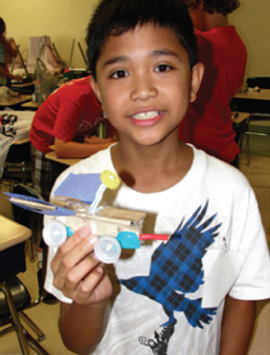My name is Patricia Moore Shaffer. I am the Evaluation Manager for the NASA Office of Education in Washington, DC, and enjoy networking with colleagues through the Washington Evaluators and the Federal Evaluator groups.
Informal learning experiences, such as summer and after-school programs or museum exhibitions, present a prime venue for fostering youth interest in science, technology, engineering, and mathematics (STEM). During a NASA Summer of Innovation camp, students might use a design process to design a lander that simulates a Martian landing or construct water-propelled engines from soft drink cans. We expect as a result of their experience that campers will develop greater interest and seek more opportunities to participate in STEM. NASA uses baseline and follow-up surveys to collect information on student attitudes toward STEM and self-reported STEM participation that primarily evaluate the impacts of the camp experience. A recent innovation in the evaluation of Summer of Innovation was the adoption of a STEM activity observation protocol—PEAR’s Dimensions of Success—in order to assess the quality of camp experiences, including the dimension of STEM engagement.
Rad Resources: There are some excellent resources for evaluating informal learning in STEM:
 Informal Science is a single destination for informal science professionals to share program descriptions, research and evaluation reports and instruments and other resources. Look for the Evidence Wiki on this website featuring summaries of what is known about informal STEM learning with citations to primary sources.
Informal Science is a single destination for informal science professionals to share program descriptions, research and evaluation reports and instruments and other resources. Look for the Evidence Wiki on this website featuring summaries of what is known about informal STEM learning with citations to primary sources.
The Framework for Evaluating Impacts of Informal Science Education Projects provides guidance on identifying appropriate impacts for informal science programs and discusses in depth how to evaluate various program areas of informal science education, including exhibitions, mass media, community and youth programs, learning technologies, and collaborations.
One of my favorite resources is Assessment Tools in Informal Science, a searchable website of assessment tools for informal science learning. This website provides evaluators and practitioners with information to choose tools for assessing STEM program quality and outcomes for children and youth.
Hot Tip: During your stay in Washington, DC, for Evaluation 2013, save a day for visiting some of the city’s great science museums, including the Koshland Science Museum, the National Geographic Museum, National Air and Space Museum, and the National Museum of Natural History. Get your geek on after the conference with a great vegetarian meal at the lively Science Club.
We’re thinking forward to October and the Evaluation 2013 annual conference all this week with our colleagues in the Local Arrangements Working Group (LAWG). Registration is now open! Do you have questions, concerns, kudos, or content to extend this aea365 contribution? Please add them in the comments section for this post on the aea365 webpage so that we may enrich our community of practice. Would you like to contribute to aea365? Review the contribution guidelines and send your draft post to aea365@eval.org.

For anyone who is looking for the updated link for the Framework for Evaluating Impacts of Informal Science Education projects, you can find it now linked on informalscience.org: http://informalscience.org/documents/Eval_Framework.pdf
Thanks for the great post!
-Kalie Sacc
Program and Community Manager
Center for Advancement of Informal Science Education (CAISE)